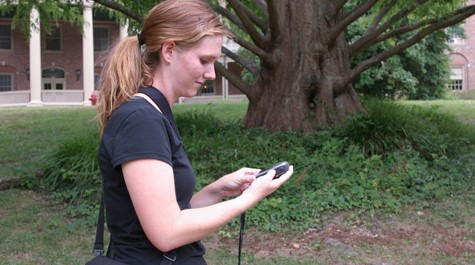Special journal issue highlights W&M legacy of songbird-mercury research
Dan Cristol started studying the effects of mercury on songbirds back in 2005, a time when many of his colleagues thought the field was a research dead end.
“Nobody was looking at mercury in songbirds back then,” he said. “People were ridiculing me for doing it.”
Cristol, a professor in William & Mary’s Department of Biology, became an expert on the subject and his work was instrumental in mercury being identified as a potential culprit in the decline of songbird population in the U.S. Cristol is the co-editor of a special issue of the journal Ecotoxicology, along with David Evers of the Biodiversity Research Institute.
The issue, titled “The impact of mercury on North American songbirds: effects, trends and predictive factors” includes papers authored by other William & Mary faculty, plus several alumni of Cristol’s lab who have gone on to earn Ph.D.s and to continue songbird/mercury research at universities across America.
But 15 years ago, people didn’t think that mercury was among the list of problems facing songbirds. Cristol said people were talking about mercury in fish-eating species such as eagles, herons and seabirds. But not songbirds. Cristol said everyone asked him the same questions: “Mercury? In songbirds? How are they going to get it?”
He explained that the songbirds were getting mercury through the double-barreled process of methylation and bioaccumulation in insects. Briefly, elementary mercury gets into the environment as an industrial pollutant. The trouble starts when bacteria process the mercury into methylmercury.
The bacteria are eaten by protozoans and other forms of life and the methylmercury is passed up along with each link of the food chain. Organisms don’t readily rid themselves of methylmercury, so by the time the food chain gets up to vertebrates such as songbirds, their bodies are dealing with the mercury taken in by all the creatures below them in the chain.
Cristol and other researchers have documented some of the dire effects that mercury has on songbirds, but America’s passerines have other problems, including but not limited to habitat loss from development and sea level rise, predation by cats and collision with buildings, towers and wind turbines. He said the idea for the special issue arose out of a conversation with Evers. They were trying to determine how mercury ranks in that list of problems facing songbirds.
“That’s the exact reason we wanted to do this special issue,” Cristol said. “We wanted to try to pull in the most current information. All the numbers we have are ballpark numbers. The number of birds killed by cats, the number of birds killed by structure collisions — all those numbers are very, very ballpark.”
And quantifying the effects of mercury on songbirds is even more challenging, he added. You can count windmills, radio towers and even get a handle on the numbers of outdoor cats.
“But there’s mercury coming down on every single inch of this country,” Cristol said. “In some places it’s really high; in some places it’s really low, but it’s everywhere.”
The big, overarching questions, he added, are how much mercury are the birds getting — and what is it doing to them?
“It’s really not possible to get an estimate of those things right now,” Cristol said.
The Ecotoxicology special issue is a good start, bringing together research reports on several bird species and how mercury affects them in the field and in the lab. The journal articles address mercury fatalities as well as the myriad insidious sublethal effects that can limit a bird’s fitness in any number of ways. For instance, Cristol pointed out studies that show that mercury can inhibit a bird’s reproductive performance, interfere with its ability to migrate and even cause it to forget where its food is.
Most researchers on the subject study mercury in the field, Cristol explained. Field work can yield insight into effects such as mortality and reproductive success, while other research groups investigate the consequences of mercury in controlled conditions.
“The two studies that I contributed to this issue, along with my students and colleagues, are both from laboratory work where we're looking very closely at what mercury is doing to these birds,” he said.
But, Cristol has done years of both lab and field work and so has been able not only to contribute to the scientific understanding of the subject, but he’s also produced a steady stream of new mercury-savvy scientists who can contribute to the field, in the field as well as the lab. Many of these scientists notched their first peer-reviewed publication as a William & Mary student and now are continuing the student-research tradition as mentors to their own undergraduate scientists.
“I just love to see that,” Cristol said. “It’s like, I raised a student who became a professor who then wants to work with undergraduates, what could be better than that?”
The Cristol-Evers special issue of Ecotoxicology focusing on mercury and songbirds in North America contains 17 articles, seven of which have authors who are currently at William & Mary or worked with Cristol as students or postdocs.
Ecotoxicology Authors with a W&M connection (and where they are today)
G. Alden Adkins ’15, physician
Rebecka Brasso M.S. ’08, now on faculty at Department of Zoology, Weber State University
Dan Cristol, Chancellor Professor, Department of Biology, W&M
Rebecca Gilson ’17, veterinarian
Allyson K. Jackson M.S. ’10, now on faculty at Department of Environmental Studies, Purchase College, SUNY
Margaret Saha, Chancellor Professor, Department of Biology, W&M
Jessica L. Spickler M.S. ’13, wildlife biologist
John Swaddle, Professor, Department of Biology, W&M
Claire Varian-Ramos, former postdoctoral researcher in WM biology department, now on faculty at Biology Department, Colorado State University - Pueblo














